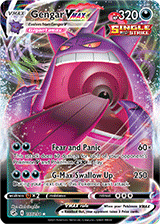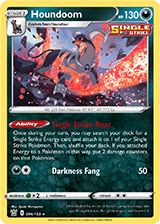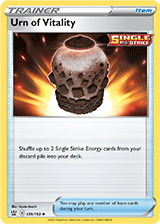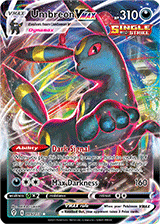A new Pokémon TCG expansion has been announced by The Pokémon Company International. Read on below to learn more:
Find out how this fearsome Fusion Strike deck’s straightforward and powerful approach can work in your next match.
By Robin Schulz, Contributing Writer
 Since the release of the Sword & Shield—Fusion Strike expansion, Mew VMAX and the Fusion Strike engine have been all the rage. But this isn’t the only Battle Style to receive support in the latest expansion. We’ve already taken a look at Rapid Strike Inteleon VMAX, and now we’ll turn our attention to a notable new Single Strike Pokémon—Gengar VMAX! It is not only a powerful card in its own right, but Gengar VMAX is also a Darkness type, which gives it a natural advantage against the aforementioned Mew VMAX. Let’s take a look at how to build a deck around this new Single Strike powerhouse.
Since the release of the Sword & Shield—Fusion Strike expansion, Mew VMAX and the Fusion Strike engine have been all the rage. But this isn’t the only Battle Style to receive support in the latest expansion. We’ve already taken a look at Rapid Strike Inteleon VMAX, and now we’ll turn our attention to a notable new Single Strike Pokémon—Gengar VMAX! It is not only a powerful card in its own right, but Gengar VMAX is also a Darkness type, which gives it a natural advantage against the aforementioned Mew VMAX. Let’s take a look at how to build a deck around this new Single Strike powerhouse.
The deck’s main cards each have two potent attacks. Gengar V‘s Pain Explosion does 190 damage for three Darkness Energy, which adds up to 230 damage if it has 2 Single Strike Energy attached. That’s enough to Knock Out almost all Basic Pokémon V, making it the ideal attack in a lot of situations. It’s a drawback that three damage counters must be put on Gengar V, but that rarely results in getting Knocked Out in return, making the attack well worth it. Gengar V’s other attack, Dark Slumber, may look unremarkable at first, but it’s a very useful option to have. Many decks don’t include a lot of ways to remove Special Conditions, so there’s a decent chance that one lucky (for you!) coinflip can leave your opponent’s Pokémon Asleep and unable to attack for a turn. Using Dark Slumber probably won’t be part of your Plan A, but having it as a backup option in case something goes wrong is certainly nice.
Gengar V is great, but on its own it will struggle to keep up with Pokémon VMAX that are out of reach of its attacks. Luckily, it does have its own evolved form! Gengar VMAX‘s G-Max Swallow Up comes in at 250 base damage, which can very reasonably be increased to 310 with three Single Strike Energy. This is enough to Knock Out most Pokémon, including the popular Jolteon VMAX and Umbreon VMAX. Attaching a fourth Single Strike Energy is a bit more difficult, but also possible, which allows it to reach 330 damage—enough to Knock Out pretty much anything. The attack does have a notable downside; Gengar VMAX is unable to attack on the following turn. However, the example decklist includes multiple cards that allow it to switch out of the Active Spot to avoid this effect.
Gengar VMAX’s Fear and Panic attack is also quite useful. Its damage output is dependent on the opponent’s number of Pokémon V in play, so it can be a bit unreliable, but unlike G-Max Swallow Up it can be used every turn for only 2 Energy. There will certainly be situations where it’s the better alternative. At the very least, it will make the opponent question whether they should put additional Pokémon on their Bench. It may also force them into suboptimal plays. On a side note, Eternatus VMAX—the one popular Pokémon that has enough HP to always withstand a G-Max Swallow Up—is heavily reliant on having many Pokémon V in play and is thus very weak to Fear and Panic. It’s nice how Gengar VMAX elegantly covers this potential weakness all on its own!
 Gengar VMAX packs quite a punch, but it does require multiple Energy to use its most powerful attack. Those Energy need to be Single Strike Energy to hit important numbers. Naturally, this makes Houndoom its perfect partner. We’ve seen this Pokémon used in various Single Strike decks before, and it’s just as good in this newest one. Gengar VMAX is slightly less reliant on Houndoom than some other Single Strike decks since its attacks don’t discard Energy and in a pinch, it can attack with just two. Nevertheless, you should always try to set up two Houndoom as soon as possible. Access to an additional Single Strike Energy can make all the difference when collecting a Knock Out, and manually drawing Energy isn’t always easy in this deck due to the limited number.
Gengar VMAX packs quite a punch, but it does require multiple Energy to use its most powerful attack. Those Energy need to be Single Strike Energy to hit important numbers. Naturally, this makes Houndoom its perfect partner. We’ve seen this Pokémon used in various Single Strike decks before, and it’s just as good in this newest one. Gengar VMAX is slightly less reliant on Houndoom than some other Single Strike decks since its attacks don’t discard Energy and in a pinch, it can attack with just two. Nevertheless, you should always try to set up two Houndoom as soon as possible. Access to an additional Single Strike Energy can make all the difference when collecting a Knock Out, and manually drawing Energy isn’t always easy in this deck due to the limited number.
Lastly, the deck includes two Crobat V for some extra draw power. It has fallen out of favor in many decks recently, but Single Strike decks don’t have great consistency, so access to Crobat V’s Dark Asset Ability is a very important option to have.
As I’ve mentioned, this deck doesn’t really have a Pokémon-based draw engine, so it must rely on a significant number of traditional draw Supporters. Professor’s Research and Marnie are generally the best available, so we play four of each. Additionally, I’ve included one Zinnia’s Resolve and one Piers; both are useful Supporter cards that let you keep your hand when they’re played.
Even though the Single Strike Battle Style focuses on dealing a lot of damage instead of drawing cards, it does get one useful consistency card—the Tower of Darkness Stadium card. For the cost of discarding a Single Strike card, it allows us to draw two cards per turn. This may not sound amazing, but it’s quite useful and worth the deck space. This deck plays a lot of Single Strike cards and can usually afford to discard some of them. For example, early in the game, you generally don’t need Urn of Vitality, while later in the game, you might want to get rid of extra copies of Houndoom. When combining the draw power of our Supporter cards and Crobat V with two additional cards per turn, we get a very solid draw engine and a consistent deck.
The deck’s item lineup is simple and all about consistency. Quick Ball is the best search card, as it gives us reliable access to Gengar V, Houndour, and Crobat V. Evolution Incense is used to find Evolutions, also a very important task. Great Ball is the weakest of the Pokémon search cards, but it’s still a card we’re always happy to draw because we want to see as many Pokémon as possible in the early turns.
 Urn of Vitality is the reason why Houndoom is such a great card and an integral part of every Single Strike deck, so it should be no surprise to see four of them in the list. This deck doesn’t need as much Energy as a Single Strike Urshifu VMAX deck, for example. Even so, it’s important to find an Urn of Vitality every time a Gengar V or Gengar VMAX gets Knocked Out. Many games come down to drawing this card at the right time, and excess copies can be used with Tower of Darkness, so there’s little reason to not play the maximum number permitted.
Urn of Vitality is the reason why Houndoom is such a great card and an integral part of every Single Strike deck, so it should be no surprise to see four of them in the list. This deck doesn’t need as much Energy as a Single Strike Urshifu VMAX deck, for example. Even so, it’s important to find an Urn of Vitality every time a Gengar V or Gengar VMAX gets Knocked Out. Many games come down to drawing this card at the right time, and excess copies can be used with Tower of Darkness, so there’s little reason to not play the maximum number permitted.
Switch is important to offset the negative effect of Gengar VMAX’s G-Max Swallow Up, allowing it to unleash massive attacks for multiple turns in a row. Remember that if a Pokémon switches out of the Active Spot, all effects on it are removed! Even if you only have a single Gengar VMAX in play, you can combine a Switch with a retreat to get it out of and then back into the Active Spot to continue attacking.
Since all the Pokémon in this deck are Darkness types with relatively high Retreat Costs, Hiding Darkness Energy is a perfect fit. Having access to such a great Energy card is amazing and makes moving Pokémon between the Active Spot and the Bench a breeze.
Aside from Hiding Darkness Energy, the list includes only the four Single Strike Energy and no Basic Energy. With Urn of Vitality to recover it, and Houndoom to get it out of the deck, you shouldn’t have trouble finding Energy when you need it. Hiding Darkness Energy is great because of its secondary effect, but manual attachments won’t be very important after the first turn or two, so playing other Energy is not needed.
This deck’s general strategy is simple: Set up a couple of Houndoom, use them to attach Single Strike Energy to your Gengar VMAX, and attack for big damage. Of course, it’s never quite that easy.
One surprisingly tricky aspect that sets Gengar VMAX apart from other Pokémon VMAX is that it has an excellent Basic version in Gengar V. Your first instinct might be to immediately evolve a Gengar V whenever possible—when using this deck, though, it makes sense to think twice about doing so. If the extra HP isn’t situationally important, or you don’t need the extra damage, attacking with regular Gengar V is completely fine! Otherwise, you may risk giving up an additional Prize card for no reason or find yourself unable to attack after a G-Max Swallow Up. The combination of powerful two- and three-Prize Pokémon is one of the deck’s biggest strengths, so try to take advantage of it!
Also, remember to keep all of the deck’s different attacks in mind. Pain Explosion and G-Max Swallow Up will without doubt be the ones you use the most, but always keep track of how many Pokémon V your opponent has in play. That way you can play Gengar VMAX’s Fear and Panic attack at opportune times. If you are unable to Knock Out an opposing Pokémon in one hit, try putting it to sleep first with Gengar V’s Dark Slumber and then finish it off with a stronger attack on the following turn.
 Since Gengar VMAX makes use of the Single Strike engine, it could be combined with other popular Single Strike Pokémon such as Umbreon VMAX or Single Strike Urshifu V. Umbreon VMAX is particularly interesting because of its Dark Signal Ability. However, because it has the same type as Gengar V and a lower damage output, it doesn’t add much attacking power to the deck. Still, if you don’t want to rely on only Boss’s Orders for targeting Benched Pokémon, Umbreon VMAX could be a worthwhile inclusion.
Since Gengar VMAX makes use of the Single Strike engine, it could be combined with other popular Single Strike Pokémon such as Umbreon VMAX or Single Strike Urshifu V. Umbreon VMAX is particularly interesting because of its Dark Signal Ability. However, because it has the same type as Gengar V and a lower damage output, it doesn’t add much attacking power to the deck. Still, if you don’t want to rely on only Boss’s Orders for targeting Benched Pokémon, Umbreon VMAX could be a worthwhile inclusion.
Another interesting Pokémon is the new Single Strike Morpeko from Sword & Shield—Fusion Strike. After attaching two Single Strike Energy to it using Houndoom’s Ability, it can attack for 160 damage. That’s very respectable for a one-Prize Pokémon. Adding this option to the deck can further increase its flexibility in the Prize race, but you need to be careful against decks with the popular Inteleon from Sword & Shield—Chilling Reign; it can easily pick off a damaged Morpeko with its Quick Shooting Ability.
One of this deck’s biggest weaknesses is its reliance on Special Energy. Fan of Waves from Sword & Shield—Battle Styles is only a slight annoyance thanks to Houndoom, but more direct counters like Duraludon VMAX or Dusknoir from Sword & Shield—Vivid Voltage are virtually impossible to overcome with this decklist. You could replace the Hiding Darkness Energy with Basic Darkness Energy, but even then, you’d be facing an uphill battle against those decks. As a Single Strike player, it’s best to accept this weakness and focus on beating other decks.
Another problem you can run into is, of course, Gengar VMAX’s Weakness to Fighting-type Pokémon. This is manageable for the most part as we expect to be trading back and forth Knock Outs, so Gengar VMAX taking extra damage doesn’t necessarily make a big difference. However, one deck that takes advantage of Gengar VMAX’s Fighting type weakness very well is Rapid Strike Urshifu VMAX. That deck typically has a lower damage output but becomes incredibly scary with Weakness advantage on its side—it’s not hard to see how this deck is one of Gengar VMAX’s toughest matchups.
Overall, despite these concerns, Gengar VMAX is a fantastic deck that’s fun to play and is well-positioned in the metagame due to its type advantage against Mew VMAX! Give it a try if you want a flexible deck that’s excellent at dealing a lot of damage, continuing the playstyle of prior Single Strike decks.
For more Pokémon TCG strategy and analysis, visit Pokemon.com/Strategy.
About the Writer

Robin Schulz
Robin Schulz is a contributing writer for Pokemon.com. He has been competing in Pokémon tournaments for 10 years and was the Pokémon TCG Masters Division World Champion in 2018. He spends a lot of time traveling and competing, and he rarely misses a big event. Aside from playing Pokémon, he attends university, where he is studying mathematics.
Source: Pokemon.com
Source: Pokemon


